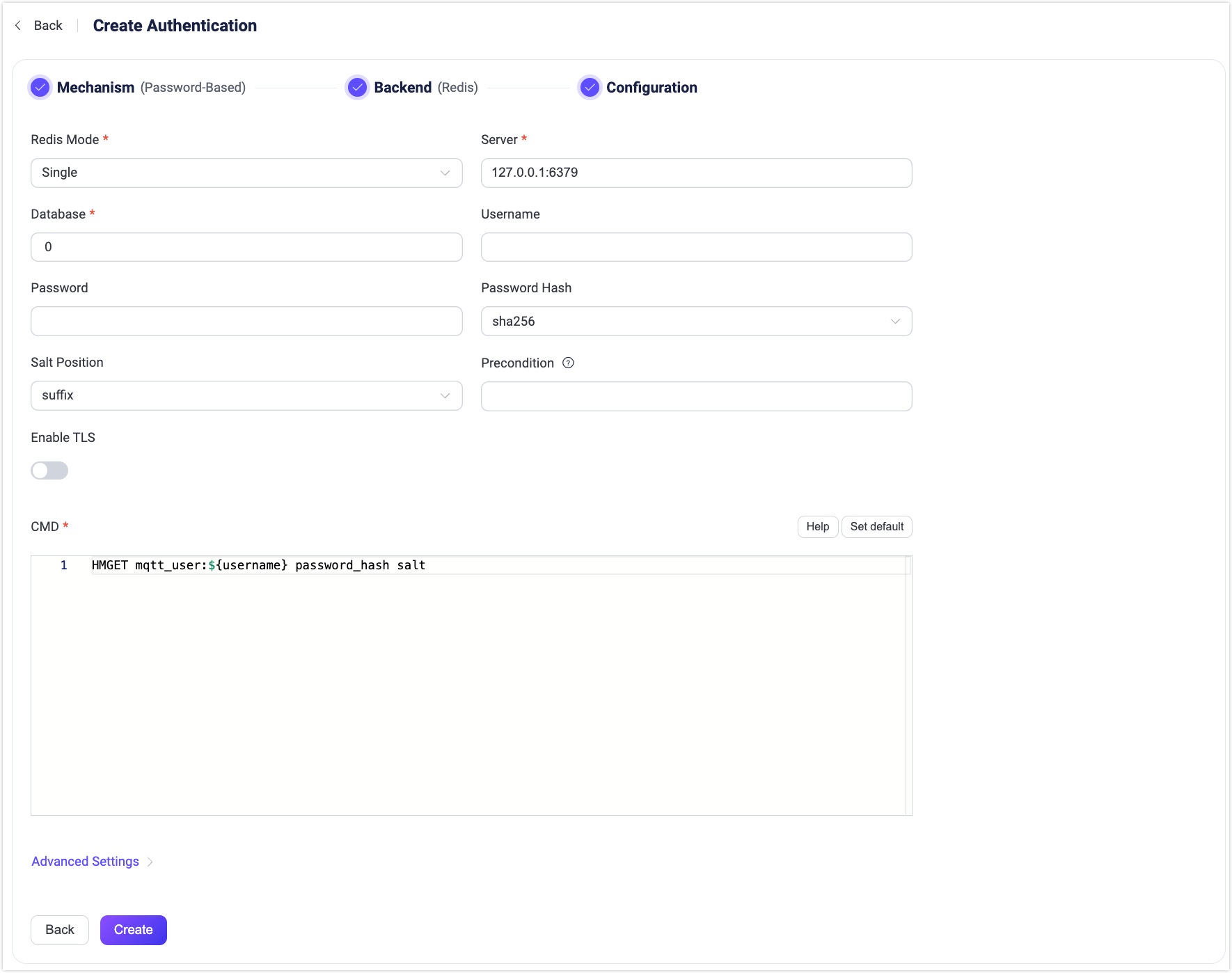Integrate with Redis
EMQX supports integrating with Redis for password authentication. EMQX Redis authenticator currently supports connecting to Redis running in three different modes, which are Single, Redis Sentinel, and Redis Cluster. This section gives detailed instructions on the data schema supported and on how to configure with EMQX Dashboard and the configuration file.
Prerequisite:
Knowledge about basic EMQX authentication concepts
Data Schema and Query Statement
Redis authentication works with credentials stored as Redis hashes with predefined field names:
password_hash: required; password (in plain text or hashed) stored in the database;salt: optional;salt = ""or just remove this field to indicate no salt value will be added;is_superuser: optional; flag if the current client is a superuser; default:false.
For example, if we want to add a document for a superuser (is_superuser: true) with username user123, password secret, prefixed salt salt, and password hash sha256, the query statement should be:
>redis-cli
127.0.0.1:6379> HSET mqtt:user123 is_superuser 1 salt salt password_hash ac63a624e7074776d677dd61a003b8c803eb11db004d0ec6ae032a5d7c9c5caf
(integer) 3The corresponding config params are:
password_hash_algorithm {
name = sha256
salt_position = prefix
}
cmd = "HMGET mqtt:${username} password_hash salt is_superuser"TIP
The name password_hash conveys our preference for storing hashed passwords. But given that Redis doesn't have a MySQL-like as syntax, EMQX 5.0 has kept the password field (in EMQX 4.x) compatible.
So, we can also configure cmd as HMGET mqtt:${username} password salt is_superuser.
Configure with Dashboard
You can use EMQX Dashboard to configure how to use Redis for password authentication.
- In the EMQX Dashboard, click Access Control -> Authentication from the left navigation menu.
- On the Authentication page, click Create in the top right corner.
- Click to select Password-Based as Mechanism, and Redis as Backend to go to the Configuration tab, as shown below.

Follow the instructions below on how to configure the authentication:
Connect: Enter the information for connecting to Redis.
Redis Mode: Select how Redis is deployed, including
Single,SentinelandCluster.Server(s): Specify the Redis server address that EMQX is to connect, if Redis Mode is set to
SentinelorCluster, you will need to input all Redis servers (separated with a,) that EMQX is to connect.Sentinel Name: Specify the name to use; type: strings; only needed if you set Redis Mode to
Sentinel.Database: Redis database name; Data type: strings.
Username: Specify the Redis username to connect with. This field is required if your Redis instance uses Redis ACL (introduced in Redis 6.0) for authentication. If your Redis server uses the default user (with ACLs disabled or not enforced), you can leave this field blank.
TIP
The
usernamefield is supported starting from EMQX 5.2.0. Ensure your deployment is running this version or later to use Redis ACL.Password: Specify the password for the Redis user. The field is required for connecting to Redis instances with authentication enabled.
- If you have entered a username, this password must match the credentials configured in your Redis ACL settings.
- If no username is provided, this password will be used to authenticate as the
defaultuser (if enabled).
TLS Configuration: Turn on the toggle switch if you want to enable TLS. For more information on enabling TLS, see Network and TLS.
Connection Configuration: Set the concurrent connections.
- Pool size (optional): Specify the number of concurrent connections from an EMQX node to a Redis server. Default:
8.
Authentication configuration: Configure settings related to authentication:
- Password Hash: Select the password hashing algorithm applied to plain-text passwords before results are stored in the database. Available options are
plain,md5,sha,sha256,sha512,bcrypt, andpbkdf2. Additional configurations depend on the selected algorithm:- For
md5,sha,sha256orsha512:- Salt Position: Determines how salt (random data) is mixed with the password. Options are
suffix,prefix, ordisable. You can keep the default value unless you migrate user credentials from external storage into the EMQX built-in database. - Resulting hash is represented as a string of hexadecimal characters, and compared case-insensitively with the stored credential.
- Salt Position: Determines how salt (random data) is mixed with the password. Options are
- For
plain:- Salt Position: should be
disable.
- Salt Position: should be
- For
bcrypt:- Salt Rounds: Defines the number of times the hash function is applied, expressed as 2Salt Rounds, also known as the "cost factor". The default value is
10, with a permissible range of5to10. A higher value is recommended for enhanced security. Note: Increasing the cost factor by 1 doubles the necessary time for authentication.
- Salt Rounds: Defines the number of times the hash function is applied, expressed as 2Salt Rounds, also known as the "cost factor". The default value is
- For
pbkdf2:- Pseudorandom Function: Selects the hash function that generates the key, such as
sha256. - Iteration Count: Sets the number of times the hash function is executed. The default is
4096. - Derived Key Length (optional): Specifies the length in bytes of the generated key. If left blank, the length will default to that determined by the selected pseudorandom function.
- Resulting hash is represented as a string of hexadecimal characters, and compared case-insensitively with the stored credential.
- Pseudorandom Function: Selects the hash function that generates the key, such as
- For
- CMD: Redis query command.
After you finish the settings, click Create.
Configure with Configuration Items
You can configure the EMQX Redis authenticator with EMQX configuration items.
Redis authentication is identified with mechanism = password_based and backend = redis.
EMQX supports working with three kinds of Redis installation.